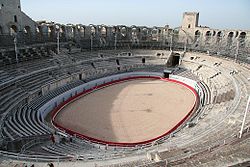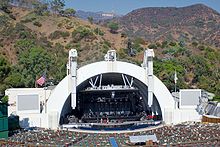- Amphitheatre
-
 Roman arena at Arles, inside view. Still in use today it draws large crowds for bullfighting[1] as well as plays and concerts in summer.
Roman arena at Arles, inside view. Still in use today it draws large crowds for bullfighting[1] as well as plays and concerts in summer.
An amphitheatre (or amphitheater) is an open-air venue used for entertainment and performances.
There are two similar, but distinct, types of structure for which the word "amphitheatre" is used: Ancient Roman amphitheatres were large central performance spaces surrounded by ascending seating, and were commonly used for spectator sports; these compare more closely to modern open-air stadiums. They were given this name because their shape resembled that of two theatres joined together. Modern amphitheatres (incorrectly so named, but the word has come to be used in this sense) are more typically used for theatrical or concert performances and typically feature a more traditionally theatrical-style stage with the audience only on one side, usually at an arc of less than a semicircle; these compare more closely to the theatres of ancient Greece, and have been more commonly built throughout history as performance spaces.
Amphitheatres are typically man-made, though there are also geological formations used in the same manner which are known as natural amphitheatres. The term derives from the ancient Greek amphi-, meaning "around", or "on both sides" and théātron, meaning "place for viewing".[2]
Contents
Roman amphitheatres
Main article: Roman amphitheatreAncient Roman amphitheaters were major public venues, circular or oval in shape, and used for events such as gladiator combats, chariot races, venationes (animal slayings) and executions. About 230 Roman amphitheatres have been found across the area of the Roman Empire. They are distinguished from circuses, from hippodromes (which were usually rectangular and built mainly for racing events) and from stadia, built for athletics.[3]
The earliest Roman amphitheatres date from the middle of the first century BC, but most were built under Imperial rule, from the Augustan period (27 BC–14 AD) onwards.[4] Imperial amphitheatres comfortably accommodated 40,000–60,000 spectators, or up to 100,000 in the largest venues. They featured multi-storeyed, arcaded façades and were elaborately decorated with marble and stucco.[5] After the end of gladiatorial games in the 3rd century and of animal killings in the sixth, most amphitheatres fell into disrepair or were razed, or they were converted into fortifications or churches.[6]
Contemporary amphitheatres
A contemporary amphitheatre, the sense in which the word has come to be used now, is a curved, acoustically vibrant performance space, particularly one located outdoors. Contemporary amphitheatres often include standing structures, called bandshells, sometimes curved or bowl-shaped, both behind the stage and behind the audience, creating an area which echoes or amplifies sound, making the amphitheatre ideal for musical or theatrical performances. Most are semicircular in shape, so they should not properly be called amphitheatres. Notable modern amphitheatres include Shoreline Amphitheatre, the Gibson Amphitheatre, and the Hollywood Bowl; the largest amphitheatre in the world is Bristol Motor Speedway in Bristol, Tennessee, with a seating capacity of 160,000.
Natural amphitheatres
A natural amphitheatre is a performance space located in a spot where a steep mountain or a particular rock formation naturally amplifies or echoes sound, making it ideal for musical and theatrical performances. The term amphitheatre can also be used to describe naturally occurring formations which would be ideal for this purpose, even if no theatre has been constructed there. Notable natural amphitheatres include the Drakensberg amphitheatre in Drakensberg, South Africa, Slane Castle in Ireland, the Supernatural Amphitheatre in Victoria, Australia, and Echo amphitheatre, Red Rocks Amphitheatre and The Gorge Amphitheatre in the United States.
See also
- Arena
- Ludus Magnus
- Stadium
- Thingplatz
- List of Roman amphitheatres
- List of contemporary amphitheatres
- List of indoor arenas
- open air, approximately semi-circular, theatres, built of stone or Roman concrete:
- List of ancient Greek theatres
- Roman theatre (structure)
Footnotes
- ^ Michel Tournier, Le coq de bruyère, W. D. Redfern, Fairleigh Dickinson Univ Press, 1996, p. 69
- ^ Hoad, T.F. (1996). The Concise Oxford Dictionary of English Etymology. Oxford University Press. pp. 14, 489. ISBN 0-19-283098-8.
- ^ Bomgardner, 37.
- ^ Bomgardner, 59.
- ^ Bomgardner, 62.
- ^ Bomgardner, 201–223.
References
- Bomgardner, David Lee (October 2000). The Story of the Roman Amphitheatre. Routledge. ISBN 0 415 16593 8.
External links
- article "Amphitheatrum" (Smith's Dictionary of Greek and Roman Antiquities)
- Caerleon amphitheatre
- Chester amphitheatre
- Pula amphitheatre
- Rome: Amphitheatrum Castrense
- France : Nimes Antique Arena
- Photos about Roman ruins in Budapest
- Roman amphitheatres
- Aerial photographs of Hungary's Amphitheatre
- Amphitheater in Petra, Jordan
Infrastructure Bridge · Canal · Dam · Drainage · Footbridge · Interchange · Levee · Overpass · Road · Skyway · Storm drain · Tunnel
See also: Architecture · Amphitheatre · Civil engineering · Construction · Playground · Urban park
Categories:- Amphitheaters
Wikimedia Foundation. 2010.



